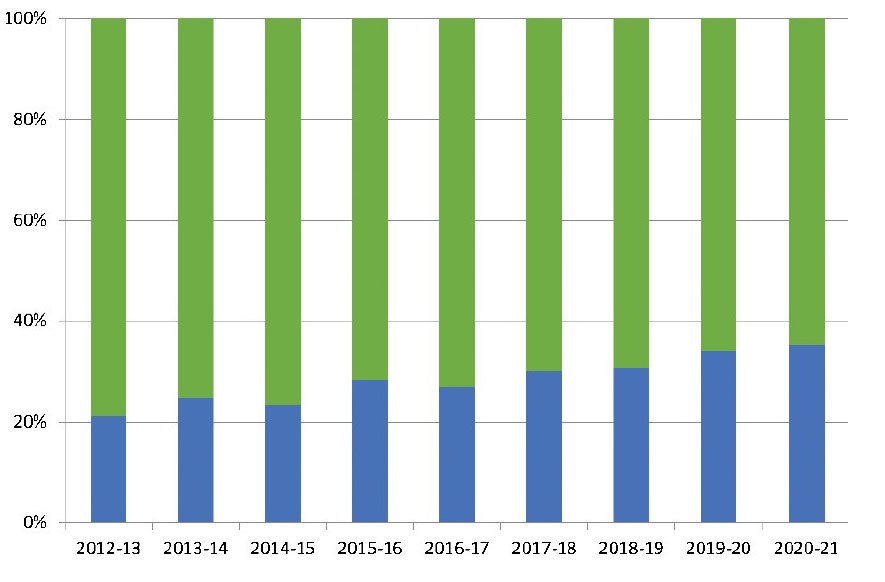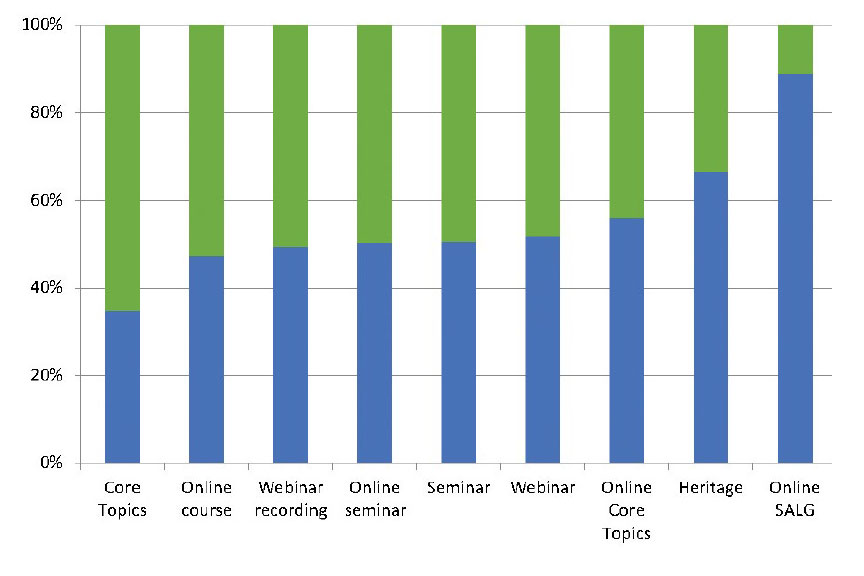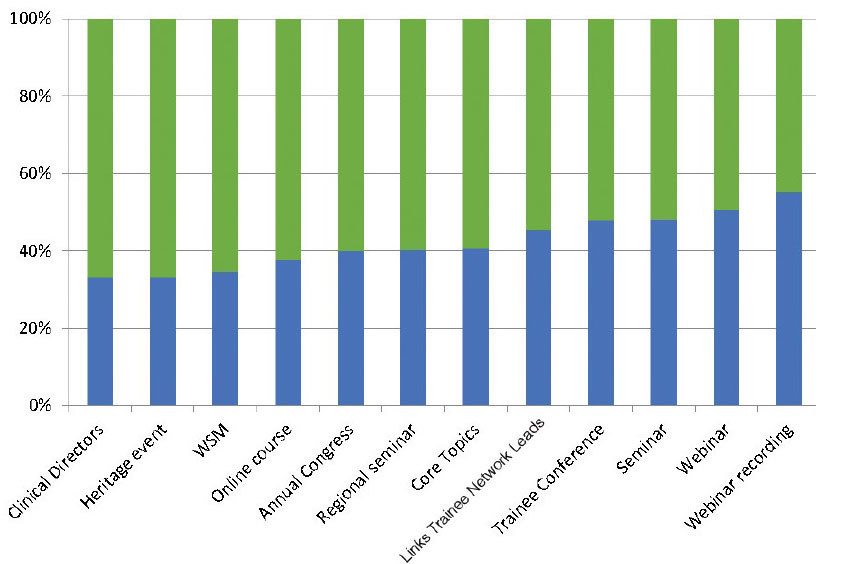On the basis of sex 2: gender balance at Association of Anaesthetists events
In 2019 the Association of Anaesthetists published an analysis of the gender of speakers at
Association events from 2012-18 [1]. This analysis showed a trend towards increased representation
of female speakers, peaking at the Winter Scientific Meeting. The proportions were, however, still
low, with a nadir of 14% at one meeting. Since then we have actively encouraged organisers of
events to consider the diversity of speakers, and all Association Committees are asked to consider
the possibility of any equality and diversity issues as part of standard activity reporting.
The social sciences have found that greater visible female representation reduces elements of bias within the wider community
Gender equity is a prominent and relevant issue within the
medical profession. Disparity has been well documented in
recent years with regard to evaluation, hiring, compensation,
and career advancement [2]; for example, 55% of UK graduates
are women, but < 25% of the most influential global healthcare
leadership positions are held by women [3]. There are a multitude
of contributors towards this inequity that we cannot hope to fully
explore in this article: implicit and explicit bias; cultural elements;
and representation of women are but a few.
Visibility is a vital element in narrowing any inequity. The social
sciences have found that greater visible female representation
reduces elements of bias within the wider community [4]. This
can include anything from workplace visibility of women in senior
positions to speakers at academic meetings. A low representation
of female physicians at academic conferences has been
recognised globally over the last decade. A cross-sectional analysis
of 701 meetings in the USA and Canada from 2007-17 found an
average of 31.8% of female speakers, with the lowest being
24.6% in 2007 [5].
Women in anaesthesia
The proportion of female consultant anaesthetists in the UK
increased from 28% in 2007 to 38% in 2020, also reflected in
an increase to a 39% female SAS workforce. The gender of
anaesthetists in training and non-consultant non-training roles is
47% female [6]. Despite this, women remain under-represented
in positions of leadership and academic practice within the
specialty. Bosco et al. performed a scoping review of 30 articles
to identify gender issues within anaesthesia [7]. They describe the
contributions of both micro- and macro-inequities that contribute
to gender disparity. Micro-inequities may be daily, intrusive gender
biases within the workplace. Macro-inequities, however, are related
to systemic issues such as promotion criteria and positions of
leadership. Membership of the Association of Anaesthetists is currently
recorded as 58% male and 42% female.
Speakers at Association events
For a number of years, we have targeted a 40% proportion
of female speakers at Association events to reflect the overall
membership. Through conscious and consistent effort, this has
increased over the last nine years from 21% to 35.4% (Figure 1).
Four of our events since 2012 have had > 40%, and 12 events
have had > 35% female speakers. Our Winter Scientific Meeting
in 2021, run as a virtual meeting, enjoyed 41% female speakers,
and inspired by the technology industry we are planning a Winter
Scientific Meeting 2022 with a 50:50 speaker gender split.
The trainee membership of the Association is 48% female, and we
therefore aim for a higher proportion of female speakers at trainee
events; however we are yet to achieve this consistently.
Below: Figure 1. Speaker gender balance at Association meetings. Blue - female

Delegates at Association events
Our proportion of female delegates for all events has increased
significantly over the last nine years from 35% to 47% (Figure 2).
Notably, female delegates find our webinars, webinar recordings
and seminars most popular. Online learning and delivery of
CPD appear to attract more female engagement, and this mode
of delivery of CPD is likely to stay with us after the pandemic.
We will continue to work to make our face-to-face meetings as
accessible as possible.
Below: Figure 2. Delegate gender balance at Association meetings. Blue - female

Changes during the COVID-19 pandemic
The Association moved quickly to providing online webinars
and educational resources in 2020. The number of delegates
increased from nearly 15,000 (2019/20) to > 34,000 (2020/21),
and the proportion of female delegates rose from 40% to 47%
(Figures 3 and 4).
Below: Figure 3. Delegate gender balance at Association meetings in 2019-20.
Blue - female

Below: Figure 4. Delegate gender balance at Association meetings in 2020.
Blue - female. SALG - Safe Anaesthesia Liaison Group

While the gender balance of our webinar speakers did not see
such a distinct rise, the proportion of females is higher than other
comparable education providers. Hall et al. reviewed anaesthesia
and intensive care medicine online webinars from March - May
2020. Women were grossly under-represented, however the
Association showed the highest female speaker proportion at 36%
compared with the lowest value of 20% [8].
The future
From September 2021 the Association will be requesting
information from members regarding protected characteristics,
which will help us to see where we need to work harder to
represent our membership to the best of our ability. The provision
of information is voluntary, will be confidential, and secure.
We will continue to promote a range of inspiring anaesthetists
from different backgrounds, and look forward to our first 50:50
gender-balanced conference at Winter Scientific Meeting 2022.
Conclusion
Gender equity is a pressing issue within anaesthesia. The
Association of Anaesthetists recognises its responsibility in
providing a platform for female speakers and delegates alike in
order to display the true gender balance within our specialty.
The hope is that continued and consistent efforts in this area
will improve access and encouragement for a more balanced
representation of women in medical leadership and academia (‘If
you can’t see it, you can’t be it’). There is always more to do, and
we welcome input from our membership in driving the equality
and diversity agenda forward.
Stuart Edwardson
Elected Member of Association of Anaesthetists Trainee Committee
ST4 Anaesthetics and Intensive Care Medicine, South East Scotland
Tei Sheraton
Honorary Membership Secretary Association of Anaesthetists
Chair of Equality and Diversity Task Group
Consultant Anaesthetist, Department of Anaesthesia, Aneurin
Bevan University Health Board, Newport
Twitter: @scotgasdoc; @liberian_girl01
References
- Miller K, Sheraton T. On the basis of sex: speakers at Association conferences.
Anaesthesia News 2019; Issue 382: 10-1.
- Cooke M. Implicit bias in academic medicine. #WhatADoctorLooksLike. JAMA
Internal Medicine
2017; 177: 657-8.
- General Medical Council. The state of medical education and practice in the UK,
2020. https://www.gmc-uk.org/about/what-we-do-and-why/data-and-research/the-state-of-medical-education-and-practice-in-the-uk (accessed 13/4/2021).
- Beaman L, Chattopadhyay R, Duflo E, Pande R, Topalova P. Powerful women:
does exposure reduce bias?
Quarterly Journal of Economics 2009; 124: 1497-
540.
- Ruzycki SM, Fletcher S, Earp M, Bharwani A, Lithgow KC. Trends in the
proportion of female speakers at medical conferences in the United States and
in Canada, 2007 to 2017.
JAMA Network Open 2019; 2: e192103.
- Royal College of Anaesthetists. Medical workforce census report 2020, 2020.
https://rcoa.ac.uk/training-careers/working-anaesthesia/workforce-planning/medical-workforce-census-report-2020 (accessed 13/4/2021).
- Bosco L, Lorello GR, Flexman AM, Hastie MJ. Women in anaesthesia: a scoping
review.
British Journal of Anaesthesia 2020; 124: e134-47.
- T Hall, C Dangoisse, V Metaxa. Where did all the women go? The
underrepresentation of women in educational resources during COVID‑19.
Intensive Care Medicine Experimental 2020; 8 (Suppl 2): 001215.